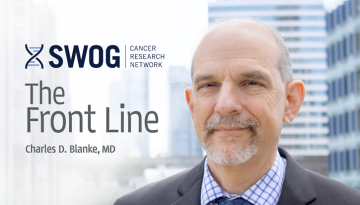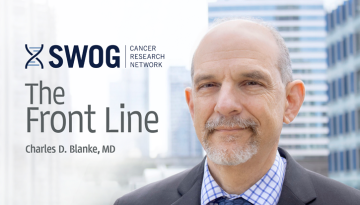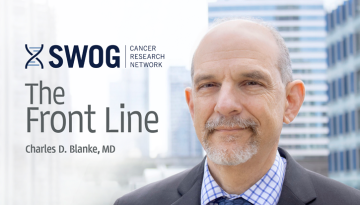SET2,3 Index Prognostic in HR+ Breast Cancer
In an analysis of data from postmenopausal patients with hormone receptor-positive breast cancer, a standard measure of gene expression known as the sensitivity-to-endocrine-therapy (SET2,3) index was found to have prognostic value that complemented the known prognostic value of the 21-gene breast recurrence score.
The findings suggest that using the two tests together may help better identify which patients will do well with endocrine therapy alone and which patients remain at high risk despite endocrine therapy and may need additional treatment.
The analysis was done by researchers from the SWOG Cancer Research Network, a cancer clinical trials group funded by the National Cancer Institute (NCI), part of the National Institutes of Health (NIH), and is being presented December 9 at the San Antonio Breast Cancer Symposium. The work was co-led by Corey W. Speers, MD, PhD, a SWOG investigator at the University of Michigan Rogel Cancer Center, and W. Fraser Symmans, MD, at MD Anderson Cancer Center.
“This study demonstrates the value and utility of using both clinical and molecular information from a patient’s tumor to guide treatment decision making,” Speers said. “Historically, recommendations about whether to use chemotherapy or hormone therapy were based on how large populations of patients responded when treated with these drugs, but this study suggests that the recommendations can be personalized for the individual patient sitting in the clinic room in front of you, allowing for more personalization of the treatment recommendations. It also underscores the continued utility of gene expression-based molecular tests in identifying women at higher or lower risk of their cancer coming back with treatment.”
The data analyzed was from patients enrolled in S8814, a large randomized clinical trial of postmenopausal patients with hormone receptor-positive breast cancer that had spread to their lymph nodes. In the original study, post-surgical treatment with chemotherapy and tamoxifen endocrine therapy was compared to treatment with tamoxifen alone. A later analysis of biospecimens and data from the study suggested that the 21-gene Oncotype DX Breast Recurrence Score (RS) test – an assay that assesses the risk a patient’s breast cancer will return – could predict which patients would benefit from chemotherapy and which could safely be treated with endocrine therapy alone. This predictive value of the RS in patients with node-positive disease was eventually confirmed in the S1007 RxPONDER study.
Speers and his colleagues wanted to learn whether the SET2,3 index could provide additional prognostic and predictive information about the S8814 patients independently of the RS.
The SET2,3 index is a measure of the level of transcriptional activity of a set of genes that are related to receptors for the hormones estrogen and progesterone. The index is adjusted based on the baseline prognosis for the individual patient, including tumor size and lymph node status.
Speers’s team examined genomic sequencing data from 283 tumors from S8814 patients. They calculated a SET2,3 index for each patient and then compared those scores to clinical outcomes data from this set of patients. They found that the distribution of low SET2,3 scores was similar across patients with high RS (greater than 25) and patients with low RS, indicating that the SET2,3 index and RS were only minimally correlated to each other. They also found that a high SET2,3 index was highly prognostic of patient outcome but did not predict whether a patient’s cancer would respond to chemotherapy. In addition, the researchers saw that while both SET2,3 index and RS were independently prognostic in this overall population of patients, among those patients who had a low RS (25 or less), only the SET2,3 index was prognostic.
“We found that the Oncotype DX Recurrence Score and the SET2,3 index offer complementary, but not identical, information about the likelihood of a woman’s cancer to recur after treatment,” Speers said. “This suggests that both tests might be useful when counseling women about the risks of their particular cancer coming back and what the most appropriate treatment strategy might be.”
The analysis was funded by the NIH/NCI through grants CA180888 and CA180819 and was supported in part by a SWOG/Hope Foundation Impact Award, Cancer Prevention and Research Institute of Texas grant award RP#180712, and by Breast Cancer Research Foundation grant award BCRF-158.
Study S8814 was sponsored by the NCI – part of the NIH – was led by SWOG, and was conducted by the NIH-funded National Clinical Trials Network (NCTN).
In addition to Speers and Symmans, the author team includes William E. Barlow, PhD, of the SWOG Statistics and Data Management Center; Alex Trevarton, PhD, of the MD Anderson Cancer Center; Stephanie The, MS, of the University of Michigan; Lili Du, PhD, of the MD Anderson Cancer Center; James M. Rae, PhD, of the University of Michigan; Steven Shak, MD, and Rick Baehner, MD, of Exact Sciences; Priyanka Sharma, MD, of the University of Kansas Medical Center; Lajos Pusztai, MD, DPhil, of the Yale University Cancer Center; Gabriel N. Hortobagyi, MD, of the MD Anderson Cancer Center; Daniel F. Hayes, MD, of the University of Michigan; Kathy S. Albain, MD, of the Loyola University Chicago Stritch School of Medicine; Andrew Godwin, PhD, of the University of Kansas Medical Center; and Alastair Thompson, MD, of the Baylor College of Medicine.
Other Recent Stories



